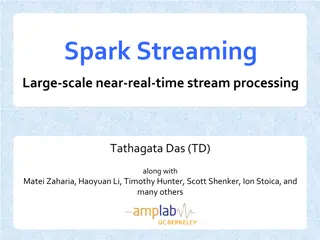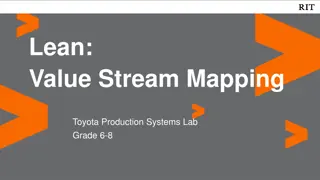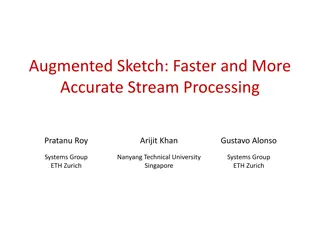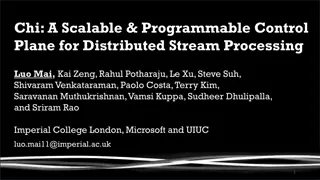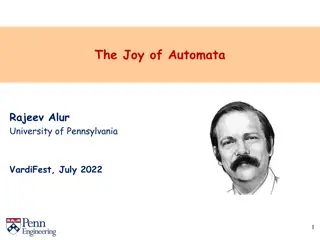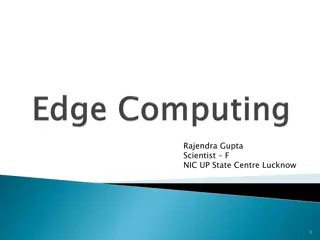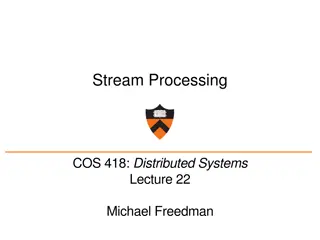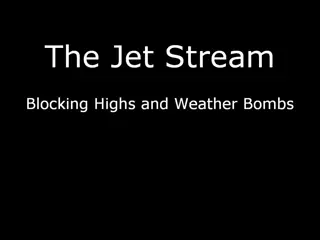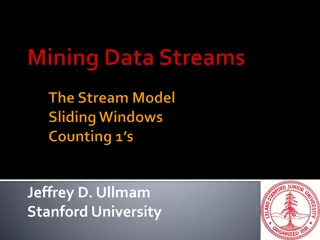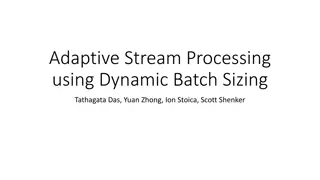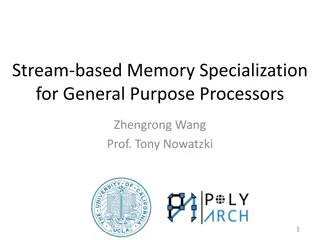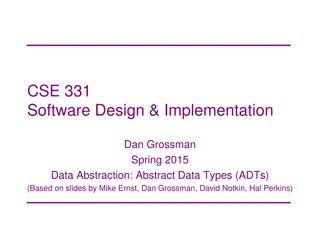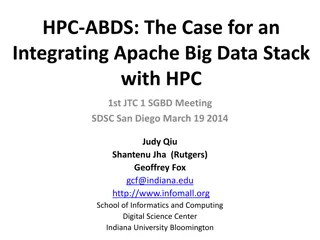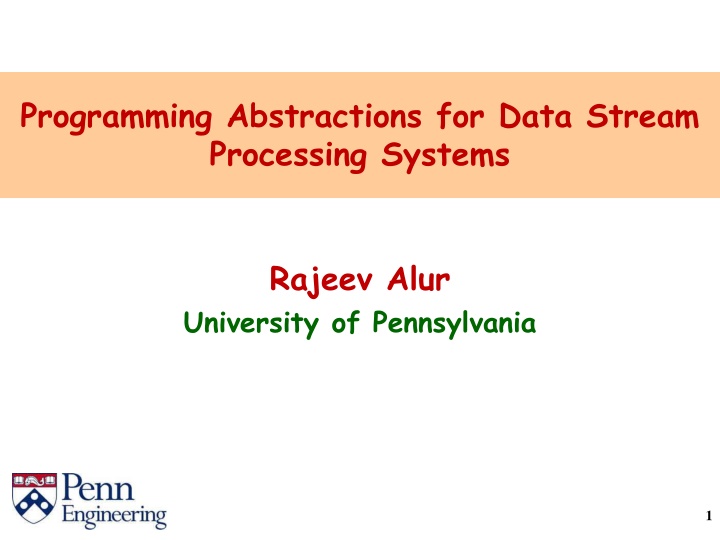
Data Stream Processing Systems and Real-time Decision Making in Smart Environments
Explore the realm of data stream processing systems, real-time decision making, network traffic engineering, safety-critical CPS, quantitative policy design, and policy implementation. Discover high-level abstractions over data streams with a focus on programming for smart environments.
Download Presentation

Please find below an Image/Link to download the presentation.
The content on the website is provided AS IS for your information and personal use only. It may not be sold, licensed, or shared on other websites without obtaining consent from the author. If you encounter any issues during the download, it is possible that the publisher has removed the file from their server.
You are allowed to download the files provided on this website for personal or commercial use, subject to the condition that they are used lawfully. All files are the property of their respective owners.
The content on the website is provided AS IS for your information and personal use only. It may not be sold, licensed, or shared on other websites without obtaining consent from the author.
E N D
Presentation Transcript
Programming Abstractions for Data Stream Processing Systems Rajeev Alur University of Pennsylvania 1
Real-time Decision Making data decisions Controller Smart buildings Network switches Autonomous medical devices Smart highways McKinsey Global Inst: $11 Trillion economy by 2025 2
Network Traffic Engineering (source IP, dest IP, payload) drop / forward to port X / alert controller Switch Dynamic network management for traffic engineering Real-time response to emerging attacks / security threats Software Defined Networking (SDN) Opportunity for increased programmability/functionality 3
Safety-critical CPS pacing stimulus Medical device software: Need and opportunity for applying formal verification Recent success in case studies (pacemaker, infusion pump) Analyzing models much easier than analyzing code Higher-level programming abstractions Easier verifiability Improved programmability Estimating energy consumption for design space exploration 4
Quantitative Policy data decisions Policy Example network policy: if number of packets in current VoIP session exceeds the average over past VoIP sessions by one standard deviation, then drop the packet Stateful: Need to maintain state and update it with each item Quantitative: Based on numerical aggregate metrics of past history 5
Design and Implementation of Policies data decisions Policy Which policies are effective ? Based on traffic models and domain specific insights How to specify and implement policies ? Focus of this talk ! Note: A policy is like a runtime monitor ! 6
Streaming Algorithm state s = initialize; for each packet p { s = update (s, p); output d = decide (s) } data decisions 7
High-level Abstractions over Data Streams ?? (source IP, dest IP, payload) drop / forward / alert controller Switch Example network policy: if number of packets in current VoIP session exceeds the average over past VoIP sessions by a standard deviation then drop the packet Low-level programming: What state to maintain? How to update it? Desired high-level abstraction: Beyond packet sequence 8
Modular Specification of VoIP Session Monitor 1. Focus on traffic between a specific source and destination 2. View data stream as a sequence of VoIP sessions Init 3. View a VoIP session as a sequence of three phases Call 4. Aggregate cost over call phase during a session, and aggregate cost across sessions End 9 Session Initiation Protocol
Design Goals for Policy Language Programming abstractions for processing data stream ?? Policy spec Theoretical foundations Expressiveness Optimization Policy compiler data Policy code decisions Efficiency critical: Key parameters 1. Time to process each packet 2. State that needs to maintained Ideally both should be constant or logarithmic in length of data stream 10
Do We Need A New Policy Language ? State-based Languages Relational languages Regular expressions Temporal logics Dataflow/synchronous languages SQL + Continuous queries Regular expressions + time windows to select events Application: Runtime monitoring Quantitative extension: Weighted automata Industrial-strength implementations IBM Streams Processing Language MSR StreamInsight / CEDR 11
Illustrative Example: Patient Monitoring Data items: Begin episode Measurement End episode End of day 145 145 152 141 150 146 160 138 Output every day, maximum over episodes during that day, average measurement during the episode 12
Regular Hierarchical Structure 145 152 141 150 146 160 138 * Episode Episode = . *. Day Day = . Episode* Regular expressions is a natural match But need a quantitative extension ! 13
Quantitative Iteration 145 152 141 150 146 f = iter(M, average) Episode : average M value h = iter (Episode, max) Atomic function M maps an item, if it is a measurement, to its value Function f maps a sequence of measurements to its average Function Episode maps an episode to average measurement within it Function h maps a sequence of episodes to the maximum episode value 14
Quantitative Regular Expressions Each QRE f maps a sequence of data items to a cost value f is a partial function from D* to C Definition parameterized by operations over the data/cost domains Example: Set of integers with min, max, sum, average Rate(f) = Subset of D* for which f is defined Rate(f) captured by symbolic regular expression Example: Rate(f) = D*. ( means that f outputs at end of each episode . *. ) 15
Quantitative Regular Expressions Summary Each QRE f maps a sequence of data items to a cost value rate(f) specifies when f produces outputs given by symbolic regular expression Core combinators: Atomic QRE: p(d) f(d) Quantitative concatenation: split(f, g, op) Quantitative iteration: iter(f, c, op) Choice: f else g Output composition: op(f1, fn) Type checking rules check compatibility of rates (decidable!) 16
Quantitative Iteration: iter(f, c, op) f is a QRE with rate r, c is a constant, and op is a binary operation matches r matches r matches r matches r f f f f c op op op op Special case: op is set-aggregator (apply op to set of returned values) max, min, sum, average, median, standard deviation Order dependent: Linear interpolation, Discounted sum 17
QRE Compilation QRE QRE compiler state s = initialize; for each packet p { s = update (s, p); output d = decide (s) } data decisions Guarantee: Data complexity: O(1) space and O(1) per item processing time Cost model: O(1) space for data values and O(1) time for data operations 18
Expressiveness of QREs Is expressiveness of QREs too limited? Why not allow all streaming algorithms? split(f, g, op)(w) = op (f(u), g(v)) if w can be split uniquely as w = u.v such that f(u) and g(v) are defined Streaming algorithms are not closed under split: f and g may be streamable but not split(f,g,op) QREs are closed under split ! 19
Expressiveness of QREs Do we have enough operators? Is expressiveness of QREs robust? Streamable Regular functions parameterized by cost operations Regular languages Regular expressions Deterministic finite automata Monadic second-order logic MSO Quantitative regular expressions Cost register automata (CRA) MSO-definable string to term transformations with forward edges Beautiful well-understood theory Emerging theory 20
Back to QRE Evaluation Algorithm QREs and CRAs are expressively equivalent Can compiling a QRE into a CRA give an optimal streaming algorithm for evaluating QREs? Recall connection between RegExp and NFA/DFA No! Translation from QRE to CRA causes exponential blow-up Deterministic simulation of unambiguous choice Intersection (due to output composition) What s a suitable model for automata-based stream processing ? POPL 19: Modular quantitative monitoring (modular compilation, can handle Temporal logic with past) 21
Implementation and Experimental Evaluation StreamQRE Java Library (PLDI 2017) NetQRE for network traffic engineering (SIGCOMM 2017) Application of StreamQRE to pacemaker design (Proc. IEEE 2019) 22
Software Defined Networking App Programmability App APIs Distributed Protocols e.g. POX, NOX, Floodlight Controller Openflow Dst A NextHop 2 Control plane Data plane Match Src=A Action drop 23
NetQRE Language (source IP, dest IP, payload) drop / forward to port X / alert controller Switch Domain-specific extension/adaptation of core QRE Basic types: ports, IP addresses, tests of packet fields Actions on packets: drop, flood, forward, augmentation with fields Reference to time windows (e.g. stream of packets in last 5 sec) Basic functions on packets (written in C) + QRE combinators (else, split, iter, max, min, sum, average) + Keys: IP addresses 24
Implementation and Evaluation NetQRE Compiler + NetQRE Runtime system (to process packets and update state) 1. Can network policies be expressed in concise and intuitive manner ? 2. Is compiled code efficient for throughput and memory footprint ? 3. Can our system be used for real-time monitoring and alerting ? Flow-level traffic measurements e.g. detection of heavy hitters, super spreaders TCP state monitoring e.g. aggregate statistics of TCP connections, detect SYN flood attack Application level monitoring e.g. collect statistics about VoIP sessions 25
Monitoring of VoIP Sessions Detect if current VoIP session is using excessive bandwidth compared of past average Init Modular specification using Map-collect on IP-addresses Split and Iter constructs Aggregation across users Aggregation across sessions Call 18 lines of NetQRE code (vs 100s of lines C++ code) End 26 Session Initiation Protocol
Throughput and Memory Footprint How does NetQRE generated code compare with hand-crafted code? Example: Detection of heavy hitters (a source IP address has consumed > K bandwidth in past T sec) Workload: CAIDA traffic trace of ~ 50 million packets Throughput (million packets per second) Manual: 10.50 vs NetQRE: 10.45 Memory: Manual: 14 MB vs NetQRE: 15.1 MB Summary for other queries (measured for 20 queries) Throughput within 4% overhead SYN flood attack: NetQRE uses twice as much memory 27
Real-Time Response Experimental setup: Network of two clients and one SDN switch SDN Controller based on POX Network emulated by Mininet with link bandwidth 100 Mbps How long does it take to detect an attack and block traffic ? Note: correction requires SDN controller to update rules on switch Incomplete TCP handshake: SYN packet, followed by matching SYNACK, but no subsequent ACK SYN flood attack: Too many incomplete TCP handshakes 28
SYN Flood Attack Attack detected and corrected by updating rules in switch Attack starts 29
Specifying Arrhythmia Detection Clinical diagnosis pacing stimulus Specification of detection policy: logical query over digitized signal Implementation: control algorithm in pacemaker Ref: QREs for Arrhythmia Detection Algorithms Abbas, Rodionova, Bartocci, Smolka, Grosu, CMSB 2017. Key resource constraint: battery life, so need optimized code Goal of case study: Methodology for estimating resource usage of alternative diagnosis policies at design time 30
Monitoring Heart Analog signal from Atrium Discrete timed events capturing peaks Discrete timed Ventricular events Analog signal from Ventricles 31
Detecting Tachycardia Ventricular Fibrillation (VFib) Delay between successive ventricular events too short Atrial Fibrillation (AFib) Delay between successive atrial events too short Ventricular Tachycardia (VT): Fatal! Sustained VFib events triggered by Vfib events Supraventricular Tachycardia (SVT) Not fatal, and ideally pacemaker should not shock heart in this case 32
End Duration Begin Duration 14 ventricular intervals 5 6 7 8 9 11 4 12 13 3 10 1 2 14 Duration: 5 seconds (C1) 3 consecutive short intervals (C3)sustained V-rate: for all windows of 10 consecutive V-intervals, 6 intervals are short (C2) 8 out of 10 intervals are short (C4) V-rate stability: low variance of interval lengths (C7) sudden onset: the heart rhythm accelerates suddenly (C5) V/A rate: average(V-rate) exceeds average(A-rate) by 10bpm VT (Deliver Shock) = C1 and C2 and C3 and C4 or C5 or ( not C6 ) or C7 (C6) AFib: for all windows of 10 consecutive A- intervals, 4 intervals are very short
Design Space Exploration with StreamQRE Goal: How to compare alternative detection policies at design time? 1. Create StreamQRE expressions for each alternative Different alternatives correspond to different parameter settings 2. Estimate per-item processing cost for each alternative By structural induction on query Need estimates of costs of basic operations (such as sum) 3. Estimate accuracy for each alternative on a database of labeled signals Sensitivity: Fraction of correctly detected VTs Specificity: Fraction of correctly detected SVTs 34
Design Space Exploration with StreamQRE Energy Estimation Energy Estimation Algorithm Algorithm Description Description Sensitivity Sensitivity Specificity Specificity all discriminators as described Baseline 100% 92.5% #3 Without sudden onset discriminator NoSO 100% 93.13% #2 Duration period set to 1 second instead of 5 Duration-1s 100% 88.54% #1 What good are StreamQRE-expression-level energy estimates? Validation: Identical ranking of resulting implementations using jRAPL simulator for estimating energy consumption Bottomline: Convenient rapid prototyping tool for comparing policies 35
Real-time Decision Making data decisions Data driven Control One research question: How to specify quantitative policies over data streams ? One solution: Quantitative Regular Expressions (QRE) Modular high-level specifications Theoretically robust expressiveness Guaranteed space/time requirements of generated code Evaluation for network traffic engineering Application: design-space exploration for Arrhythmia detection 36
Learning ?? (source IP, dest IP, payload) drop / forward to port X / alert controller Switch What traffic constitutes an attack ? Known patterns can be captured by, say, QREs, but can the switch dynamically learn the attack pattern? Research opportunity: Learning high-level declarative patterns, say QREs, more plausible than learning low-level code 37
Distributed Processing ?? Logical query on partially ordered stream of data Physical implementation: distributed system How to ensure consistency ? High performance ? Resilience to errors ? Emerging architectures: Apache STORM 38
Thanks to Collaborators Dana Fisman Sanjeev Khanna Houssam Abbas Zack Ives Rahul Mangharam Boon Thau Loo Kostas Mamouras Mukund Raghothaman Yifei Yuan Alena Rodionova Val Tannen 39 Caleb Stanford



